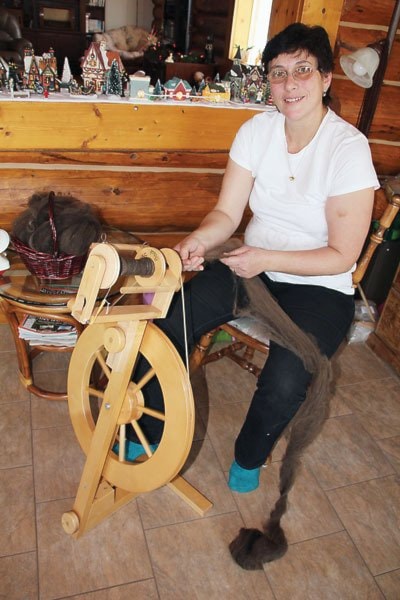When Rosi Salzbrenner and her husband, Thomas, came to Lone Butte in 2004, they and their blended family made a total of six.
Just three years later, Rosi discovered alpacas and fell in love again. Now, the family count stands at 26, after three of the children grew up and set out on their own and 23 of the cuddly doe-eyed alpacas moved in.
No matter how much research she did, Rosi couldn't find any downfalls associated with the curious cousin of the camel, and now, several years later, she's still enamored with them.
Collecting alpacas became a passion and each one has been lovingly named after a variety of either coffee or chocolate. In the mix are Cappuccino, Cinnamon, Caramilk and Toffee.
The animals are easy to keep Rosi says, adding they don't require a lot of high-quality food, and because they are camelids, don't need much water either. History dates domestic alpacas back 5,000 years to the high-altitude regions of South America where they are still found in large numbers today. They adapted well to the sparse conditions and among their many unique traits is their habit of using a communal dung pile, which prevents contamination of precious grazing land and limits the spread of internal parasites.
Rosi says she never has to worry about alpaca babies being inconveniently born in the middle of the night because the animals have developed the ability to regulate birthing so it takes place between 8 a.m. and 4 p.m.
Nights are cold in their mountainous homeland and daytime birthing ensures that the young enter the world during the warmest part of the day.
Their traditional environment also caused alpacas to develop thick, warm woolly coats, which when shorn, can be spun into luxurious silky yarn. It is highly sought by knitters and weavers.
Rosi has her animals shorn once a year, with each producing between two and 10 pounds (1-4.5 kilograms) of wool. She cards and packages the raw material in personalized gift baskets that include a photo and bio of the animal it came from, and then sells it.
She keeps plenty for herself, spinning much of it for in knitting all kinds of cozy items.
Spinning is something relatively new for Rosi and it started with a spinning wheel, which she picked up for $35 at a garage sale. Learning the technique was frustrating business, but it became easier after she attended a workshop hosted by the local South Cariboo Weavers and Spinners Guild. They encouraged her to keep at it and guided her through the rough spots.
"It was tough co-ordinating my hands and feet. It took a year to get the knack, but I'm not one to give up."
Her first strands hang in a looped bundle on the wall to remind her of the journey.
Her next goal is to learn the art of weaving but she'd like to have her spinning technique perfected before heading out in a new direction.
Rosi fits in a bit of spinning where she can, during a few spare moments between caring for her alpaca herd and seeing to guests who visit her little German cafe, which is a part of the house and overlooks the immaculately kept farm yard.
Rosi is also an accomplished baker and welcomes the public into her little home-based Alpaca Coffee House in the summer for lunch items, European pastries and coffee.
Guests are encouraged to make their way to the nearby alpaca corral to visit with the animals who are a bit shy, but curious by nature. They group together and cautiously check out strangers, with some enjoying a scratch on the head or a belly rub.
Smaller in stature than their cousin the llama and mild mannered, alpacas are very approachable, especially for children who have the patience to let them approach. It's different when Rosi enters the alpaca pen as the herd quickly surrounds her and each waits their turn for a gentle caress or kiss on the snout. Soft coos can be heard from some, as that's how they communicate.
"I love these animals dearly," Rosi says about her unique furry friends who have made themselves part of the Salzbrenner family.
